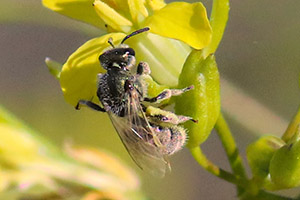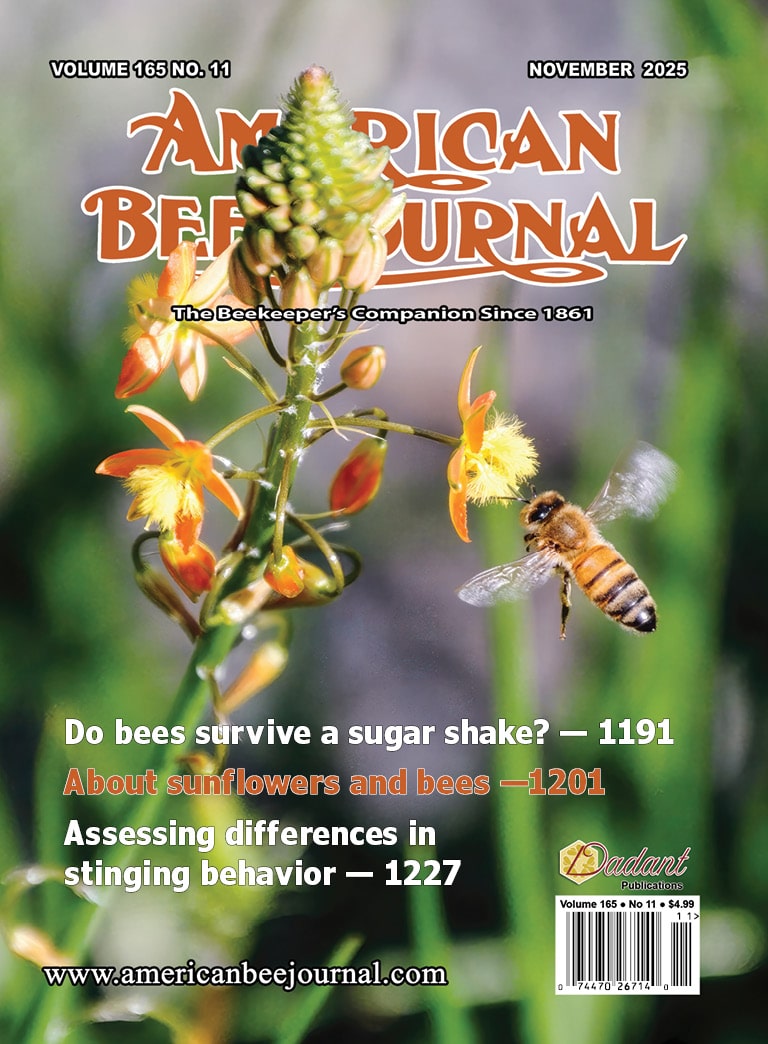
I awoke to wind. In the faint moon glow, I could see a chain of poplars silhouetted against the sky, the upper branches tossing and thrashing. Individual trees synchronized into a chorus line, bending with the rhythm of each successive gust. The musky essence of sagebrush reminded me I wasn’t home.
Each time I visit the desert, I wonder about the night winds. Why does a barren landscape, still as death during the day, come alive at night? Why do undulating rows of windmills that turn lazily by day, spin like crazed pinwheels under darkened skies?
As I watched the trees, I heard a short yip, a single chirp from a lone coyote. Moments later, a second bark was followed by a protracted howl. The plaintive cry was soon answered by another. And another. Within moments, a frenzy of disparate screams, sounding both cunning and vicious, reverberated from the sage. Feeling like a piece of meat, I shivered and cuddled deeper into my sleeping bag.
Departing on a Bee Safari
Summer bee safaris are a highlight of my year. All winter long, holed up in the sodden darkness of the 47th parallel, I think about where I will go and what bees I will see. Once Earth warms in spring, I leave home — my pickup laden with nets and tripods, cameras and peanut butter — in search of a bee I’ve never seen and a story I’ve never told.
Of course, the obvious place for bee hunting is the desert. Bees evolved in arid climates, and deserts are hot spots of bee biodiversity. The biggest and the smallest, the prettiest and the weirdest all live in the desert, waiting for the ephemeral bloom that will keep them barely alive for another year.
Encircled in the Wind
The lonely howl of wind and coyotes reminded me of a previous bee trip. Camped on a desolate wildlife preserve in Oklahoma, the night wind arrived like a freight train, deafening and powerful. My daughter tied our tent to the bumper of her car and hoped the fabric wouldn’t tear itself apart. We ate a quick meal of stale granola bars and cold hot chocolate, then unrolled our bags, shouting to be heard though we were just inches apart.
As twilight fell, a battered pickup appeared in the lonely outpost. Through the dim light and the crash of wind we could see three men in the front seat and twice as many rifles mounted across the rear window. A perimeter road circled the campground, but we were the only tenants. After the truck slowly passed our site and disappeared behind a pile of boulders, we breathed a sigh of relief.
But five minutes later, the menace returned, having circled the entire camping area. Because of the wind, we couldn’t hear the truck approach, so it was only yards from us when its high beams penetrated our nylon walls. This time the truck crept by even more slowly, but all we could hear was our own pumping hearts against the scream of the wind. Ker-thump. Ker-thump.
We took stock of our situation and decided it was bad. With no one else around for miles, we were at their mercy, and because we couldn’t tell if we were being taunted or stalked, we decided to flee. Regardless of their agenda, we decided our campsite wasn’t worth fighting for.
As soon as the truck dipped behind the boulders a second time, we frantically cut the ties to the tent, stuffed everything into the backseat, and hightailed out of there. As we bumped down the gravel road, we could see the lights of the pickup as it slowly began its third circuit.
Although neither of us likes to fold in the face of danger, it seemed like an excellent opportunity to cut bait and run. My daughter, a combat veteran who had just returned from Iraq, said it was one of the scariest moments of her life.
Potholes State Park
Potholes State Park in eastern Washington is not named for an unkempt road but for giant potholes that were formed from flooding during the Pleistocene. The sunken saucers vary from 30 to 70 yards across, and from 10 to 60 feet deep. Until the 1950s they remained dry and dusty, but after the completion of the O’Sullivan Dam in 1949, things began to change. As the water table rose, the potholes began to fill from the bottom, eventually becoming little lakes.
The state park is at the southern end of the reservoir and is a popular spot for year-round fishing. Sure enough, as I got close, the scent of aquatic life overwhelmed me. The brackish odor was an odd counterpoint to the aroma of sage — like fish with stuffing. It brought back memories of the crunchy baguettes and cheese we ate when I worked on Cape Cod and thrived on the tang of the sea.
Insects, Not Mosquitoes
When I first arrived at my campsite I was greeted by great clouds of insects. They hovered around me like mosquitoes, quivered in the air, and whispered in whiny high-pitched frequencies. A couple of times I breathed them in like black flies and swallowed some that wedged in my throat. No amount of water dislodged their creepy skeletons, and I imagined wet insect wings — body still attached and legs kicking — stuck to the back of my tongue. I was chagrined. How could I photograph bees while breathing in mosquitoes, probably blood-laden ones, at that?
Thing is, they didn’t seem to bite. Even after hours in their disconcerting presence, I hadn’t a single welt. It was then I began to ….


